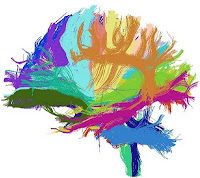 |
| Schematic of a 'peripheral' myelinated axon |
Your electrical wiring to your ceiling fan would include a switch and the fan itself. The wire (cable) from the switch would ascend vertically up the wall, make a 90 degree angle, and then reach the fan horizontally up in the ceiling. Likewise, in our brain, which is made up of two hemispheres, would connect. Three broad fiber types are seen: from one hemisphere to the other (commisural fibers), restricted to one hemisphere (front to back or antero-posteriorly are association fibers) and finally vertically (up down orientation go the projection fibers).
Exploring the tracts can now be done in live animals including humans. Improvement in MRI technology has enabled us to see the tracts (tractography). Improved gradient coils, faster processors and superior software have shortened the scanning time, thereby reducing 'blur' due to organ movement (e.g. diaphragm) and patient movement. This procedure called Echo Planar Imaging (EPI) has given birth to Functional Magnetic Resonance Imaging (fMRI), Diffusion Weighted Imaging (DWI), tractography and many other diagnostic and research procedures.
Consider the neuron shown in the above picture. Water molecules in the axon (yellow) are constantly in Brownian (random) motion due to thermal energy within. Hence they tend to diffuse constantly to come to equilibrium. In most of the cerebrospinal fluid spaces these microscopic motions are equal in all directions. This is called isotropic diffusion. But in myelinated neurons, as in the white matter fiber tracts, water motion is constrained due to the fatty nature of the myelin sheath (in blue) which hinders water flow across it. This anisotropic diffusion allows the flow of more water molecules along (parallel) the direction of the nerve fiber. The apparent diffusion coefficient (ADC) is thus more along the nerve fiber. Diffusion Weighted Imaging (DWI) can capture this microscopic water flow and delineate anatomically the orientation of nerve fiber tracts.
Pyogenic abscesses hinder diffusion by virtue of their increased viscosity, a rheological property. In the early stages of acute cerebral infarction there is reduced diffusion too, giving rise to high signal intensity. However, in most pathologies of the brain the ADC is increased. Diffusion Tensor Imaging (DTI), a diffusion MRI technology, tracks fiber orientation by assigning values in ellipsoid voxels (VOlume piXEL). Ellipsoid because unlike isotropic diffusion where molecules diffuse equally in all directions, the anisotropy in the white matter tracts does not permit them to move with equal ease in all directions, and hence the pattern is that of an ellipsoid and not spherical. By connecting the long axes of all the ellipsoids, the trajectory/orientation is deduced.
Colors are added to it with respect to the three principal axes (x, y and z)
 and the result is a stunning tractography! (see left)
and the result is a stunning tractography! (see left)The YouTube video below describes the colorful realms of tractography and how they are used.
When fMRI and DTI are combined together, a whole new world emerges. But, I prefer to keep it on hold till I discuss Functional Magnetic Resonance Imaging.
NB: The picture of the neuron/axon shown is not representative of CNS neurons. Oligodendrocytes that form myelin in the CNS does not encircle so many times as the Schwann cells in peripheral neurons do. It has been shown here only for the sake of clarity.
Last modified: Mar 10, 2014
Reference: Diffusion Tensor Tractography: Exploring the Cost-Benefit Ratio of Incorporating CSF Suppression into Fiber Tracing Algorithms
William P. Dillon. Neuroimaging in Neurologic Disorders. In: Harrison's Principles of Internal Medicine, 17th Ed., Volume 2, McGraw Hill; 2008. p. 2491-2497.
P. Mukherjee,, J.I. Berman,, S.W. Chung,, C.P. Hess, & R.G. Henry (2008). Diffusion Tensor MR Imaging and Fiber Tractography: Theoretic Underpinnings AM J Neuroradiol DOI: 10.3174/ajnr.A1051
No comments:
Post a Comment